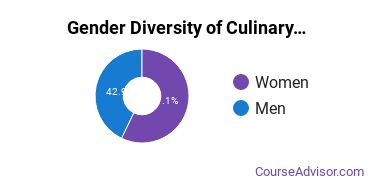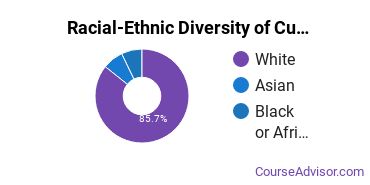Culinary Arts at Indiana University of Pennsylvania - Main Campus
IUP is located in Indiana, Pennsylvania and approximately 10,037 students attend the school each year.
Want to know more about the career opportunities in this field? Check out the Careers in Culinary Arts section at the bottom of this page.
Featured schools near , edit
IUP Culinary Arts Degrees Available
- Undergrad Certificate in Culinary Arts (1 - 4 Years)
- Associate’s Degree in Culinary Arts
IUP Culinary Arts Rankings
Note: Although rankings can help you see some information about a school, it's not a good idea to depend on them alone. Be sure to check out other things about the school before making your decision to attend.
Culinary Arts Student Demographics at IUP
Take a look at the following statistics related to the make-up of the culinary arts majors at Indiana University of Pennsylvania - Main Campus.
IUP Culinary Arts Associate’s Program

The majority of those who receive an associate's degree in culinary arts at IUP are white. Around 86% fell into this category, which is below average for this degree.
The following table and chart show the race/ethnicity for students who recently graduated from Indiana University of Pennsylvania - Main Campus with a associate's in culinary arts.

| Race/Ethnicity | Number of Students |
|---|---|
| Asian | 1 |
| Black or African American | 1 |
| Hispanic or Latino | 0 |
| White | 12 |
| International Students | 0 |
| Other Races/Ethnicities | 0 |
Related Majors
Careers That Culinary Arts Grads May Go Into
A degree in culinary arts can lead to the following careers. Since job numbers and average salaries can vary by geographic location, we have only included the numbers for PA, the home state for Indiana University of Pennsylvania - Main Campus.
| Occupation | Jobs in PA | Average Salary in PA |
|---|---|---|
| Restaurant Cooks | 55,980 | $26,510 |
| Food Preparation and Serving Worker Supervisors | 37,440 | $38,570 |
| Bartenders | 33,150 | $23,380 |
| Institution and Cafeteria Cooks | 15,960 | $29,180 |
| Bakers | 9,040 | $27,110 |
References
*The racial-ethnic minorities count is calculated by taking the total number of students and subtracting white students, international students, and students whose race/ethnicity was unknown. This number is then divided by the total number of students at the school to obtain the racial-ethnic minorities percentage.
- College Factual
- National Center for Education Statistics
- O*NET Online
- Image Credit: By Canadian2006 under License
More about our data sources and methodologies.
Featured Schools
 Request Info
Request Info
|
Southern New Hampshire University You have goals. Southern New Hampshire University can help you get there. Whether you need a bachelor's degree to get into a career or want a master's degree to move up in your current career, SNHU has an online program for you. Find your degree from over 200 online programs. Learn More > |
